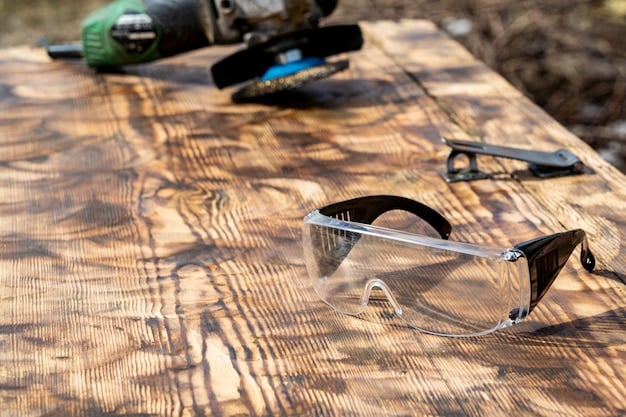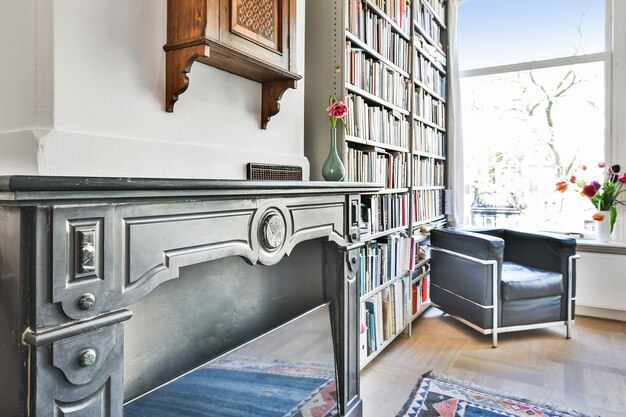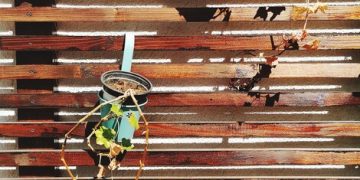Create a Cozy Reading Nook: DIY Bench with Book Storage

Anúncios
Create a cozy nook with a DIY reading bench featuring built-in book storage, a perfect weekend project that combines functionality with personalized comfort, enhancing any reading space.
Transforming a corner of your home into a personal reading haven is easier than you might think. This guide will walk you through how to create a cozy nook with a DIY reading bench complete with integrated book storage, making it both functional and stylish.
Anúncios
Planning Your DIY Reading Bench
Before diving into the construction, planning is key to ensuring your DIY reading bench fits perfectly into your space and meets your needs. This involves measuring your area, deciding on the bench’s dimensions, and choosing the right materials.
Start by assessing the available space. A small corner may only accommodate a smaller bench, while a larger area can handle a more expansive design. Consider the height, width, and depth carefully to ensure the bench is comfortable and doesn’t overwhelm the room.
Anúncios
Choosing the Right Materials
Selecting the right materials not only affects the appearance of your reading bench but also its durability and longevity. Common choices include wood, plywood, and repurposed materials.
- Wood: Offers a classic look and is sturdy. Pine is affordable and easy to work with, while oak and maple provide a more premium feel.
- Plywood: A cost-effective option that provides a smooth surface for painting or staining. Ensure to use a grade suitable for furniture making.
- Repurposed Materials: Consider using old pallets, doors, or drawers for a unique, eco-friendly bench.
Sketching Your Design
A detailed sketch is essential for visualizing your final product and guiding your construction. Include all dimensions and consider adding elements like a backrest, armrests, or additional storage compartments. This step helps identify potential issues and allows for adjustments before you start cutting wood.
Investing time in the planning phase sets the stage for a successful and enjoyable DIY project. With a clear vision and the right materials, you’ll be well on your way to creating cozy nook that you’ll love.
Gathering Your Tools and Materials
Having the right tools and materials on hand will make building your DIY reading bench much smoother and more efficient. Organization is also key, so gather everything in your workspace before you get started.
Essential tools include a saw (circular or hand saw), drill, screwdriver, measuring tape, pencil, sandpaper, and safety glasses. Depending on your design, you may also need a wood planer, clamps, and a level.
Shopping for Lumber and Hardware
Make a detailed list of the lumber, screws, nails, and any decorative hardware you’ll need. This ensures you won’t have to make last-minute trips to the hardware store. When choosing lumber, inspect each piece for knots, warping, or other imperfections that could affect the strength and appearance of your bench.
Consider purchasing additional wood. This will cover any miscuts or design changes during the building process. Hardware such as screws, nails, and wood glue are critical for assembling a study structure.
With the right tools and materials prepared in advance, the construction process can be streamlined. Properly organizing your workspace and understanding the function of each tool will make the project not only easier but also more enjoyable.
Constructing the Bench Frame
The foundation of your DIY reading bench is the frame. Ensuring it is sturdy and square is crucial for the longevity and stability of the bench. Precision and careful assembly are critical at this stage.
Using your measurements from the planning phase, accurately cut the lumber for the frame. Double-check each cut to ensure the correct length and angle. Minor errors at this stage can compound later, affecting the final product.
Assembling the Frame
Begin by assembling the main structure, typically a rectangular base. Use screws and wood glue to secure the joints. Clamps can be helpful to hold the pieces together while the glue dries. Periodically check for squareness using a carpenter’s square to avoid歪斜。
Once the main frame is secure, add internal supports to provide extra strength and prevent the bench from sagging over time. These supports can be as simple as additional pieces of lumber placed perpendicular to the main frame.
- Pre-Drilling: Always pre-drill holes before driving in screws to prevent the wood from splitting.
- Wood Glue: Apply wood glue to all joints for added strength and durability.
- Clamping: Use clamps to hold pieces together while the glue dries, typically for at least 30 minutes.
With a solid understanding of these techniques, you can construct a sturdy frame that serves as the backbone for your reading bench. Remember, patience and attention to detail are key to achieving professional-quality results in your DIY project.
Building the Book Storage Compartments
Integrating book storage into your reading bench adds both functionality and aesthetic appeal. Designing and building these storage compartments requires careful planning and precise execution.
Consider the type of storage you need. Open shelves are ideal for easily accessible books and décor, while closed compartments can hide clutter and provide a cleaner look. Determine the dimensions of your storage spaces based on the size of your books and the overall design of the bench.
Creating Shelves and Dividers
Cut the lumber or plywood for the shelves and dividers according to your planned dimensions. Use a level to ensure each shelf is perfectly horizontal before securing it with screws and wood glue. Dividers can be added to create smaller compartments for organizing books or displaying small items.
- Pocket Holes: Use a pocket hole jig for creating strong and concealed joints when attaching shelves.
- Routing Edges: Consider routing the edges of the shelves for a more refined and professional look.
- Adjustable Shelves: Install shelf pins to allow for adjustable shelf heights, providing flexibility for different sizes of books.
The addition of book storage compartments not only enhances the functionality of your reading bench but also adds to its aesthetic appeal. Thoughtful design and careful construction result in a piece that is both beautiful and practical.
Adding Finishing Touches
The finishing touches can significantly enhance the appearance and comfort of your DIY reading bench. From sanding and painting to adding cushions and décor, these steps transform a basic structure into a cozy and inviting space.
Start by thoroughly sanding all surfaces to remove any rough edges or splinters. A smooth surface is essential for applying paint or stain evenly and for ensuring comfort when using the bench.
Painting or Staining the Bench
Before painting or staining, apply a wood primer to seal the surface and provide a better base for the finish. Choose a paint or stain that complements your décor and matches the style of your room. Apply multiple thin coats, allowing each coat to dry completely before applying the next.
Once the paint or stain is dry, consider adding a clear coat of polyurethane to protect the finish and provide added durability. This is especially important for surfaces that will see heavy use.
The addition of cushions and pillows transforms the bench into a cozy reading spot. Choose fabrics and colors that complement your décor and provide comfortable support. Add a soft blanket for extra warmth and texture.
Accessorizing Your Reading Nook
Personal touches, such as a reading lamp, a small table for drinks, and decorative items, complete the transformation of your reading nook. Consider adding plants, artwork, or other elements that reflect your personality and create a relaxing atmosphere. You can also install a small shelf for a mug.
With careful attention to these finishing touches, your DIY reading bench can become a stylish and comfortable addition to your home.
Maintaining and Enjoying Your Cozy Nook
Once your DIY reading bench is complete, proper maintenance will ensure it remains a comfortable and inviting space for years to come. Regular cleaning and minor repairs can prevent wear and tear and keep your nook looking its best.
Dust the bench regularly with a soft cloth to prevent the buildup of dirt and grime. Use a damp cloth to wipe down painted or stained surfaces, but avoid using harsh chemicals or abrasive cleaners that could damage the finish.
- Cushion Care: Vacuum cushions regularly to remove dust and crumbs. Spot clean any spills or stains immediately to prevent them from setting.
- Wood Protection: Apply a fresh coat of polyurethane every few years to protect the wood and maintain its finish.
Take time to relax and enjoy the space you’ve created. A well-designed reading nook can be a sanctuary where you can escape the stresses of daily life and immerse yourself in a good book. Add personalized elements such as artwork, plants, or a favorite mug to make the space truly your own.
By combining regular maintenance with thoughtful enjoyment, you can ensure that your DIY reading bench continues to provide comfort and relaxation for many years.
| Key Point | Brief Description |
|---|---|
| 📏 Planning Phase | Measure space and sketch design to tailor the bench. |
| 🛠️ Construction | Assemble frame, add supports, and build storage. |
| 🎨 Finishing | Sand, paint/stain, and add cushions and accessories. |
| 📚 Maintenance | Regularly clean and protect to maintain durability. |
FAQ
▼
Wood is a classic choice for reading benches, providing durability and aesthetic appeal. Options like pine are affordable, while oak offers a more premium feel. Additional options are plywood and repurposing materials.
▼
Use screws and wood glue to secure the joints, and always pre-drill holes to prevent the wood from splitting. Clamps can hold pieces together while the glue dries. Don’t forget to check for squareness.
▼
Open shelves are great for easily accessible books, while closed compartments can hide clutter. Consider the size of your books and the overall design of the bench when making your decision.
▼
Begin by sanding all surfaces, then applying a wood primer before painting or staining. After it dries, add a clear coat of polyurethane for protection. Cushions and pillows will add comfort.
▼
Regularly dust the bench with a soft cloth and use a damp cloth to wipe down painted surfaces. Vacuum cushions and spot clean spills immediately. Apply a fresh coat of polyurethane every few years.
Conclusion
Creating a cozy reading nook with a DIY bench and built-in storage is a fulfilling and rewarding project. By following these steps, you can transform any space into a comfortable and stylish haven for reading and relaxation. Enjoy your new cozy corner!







